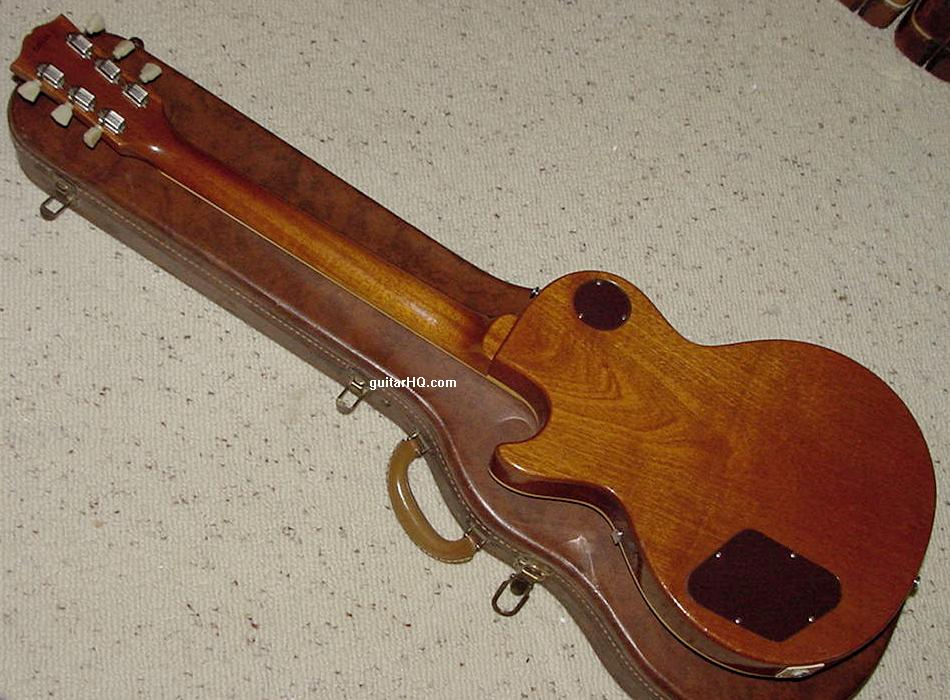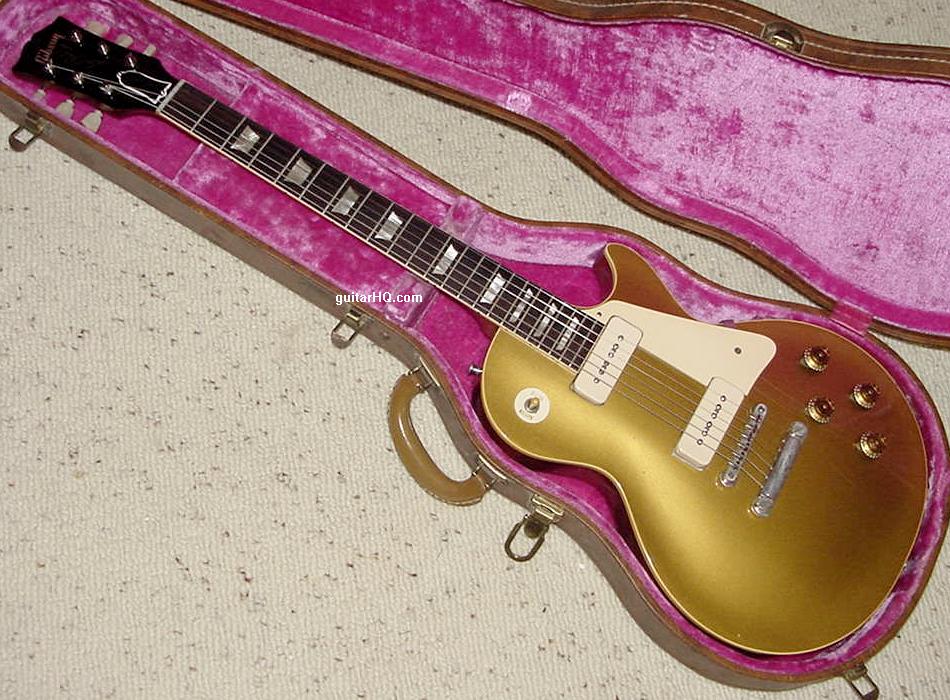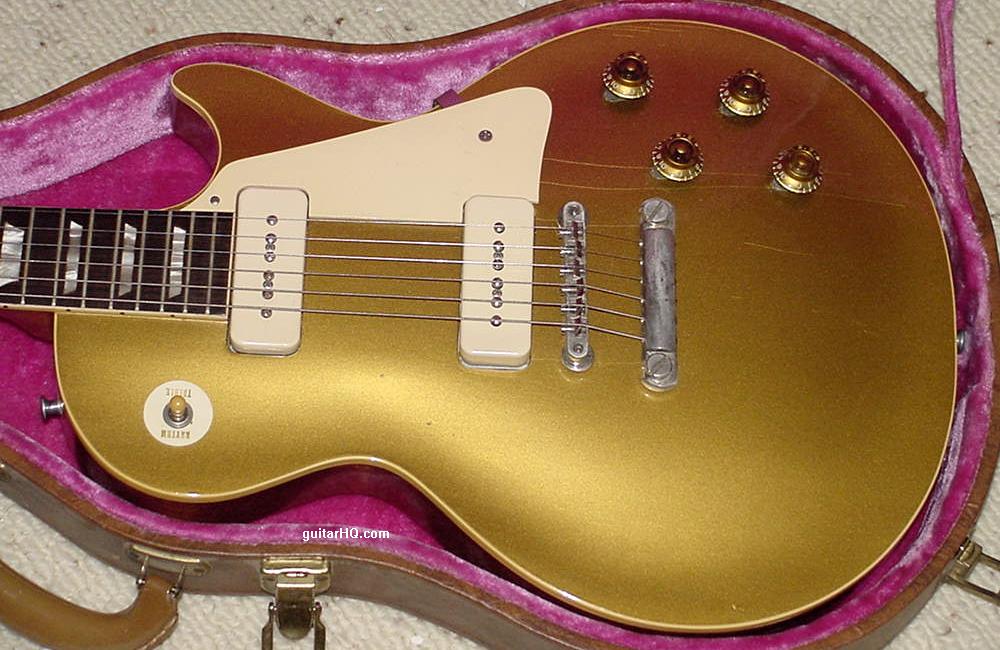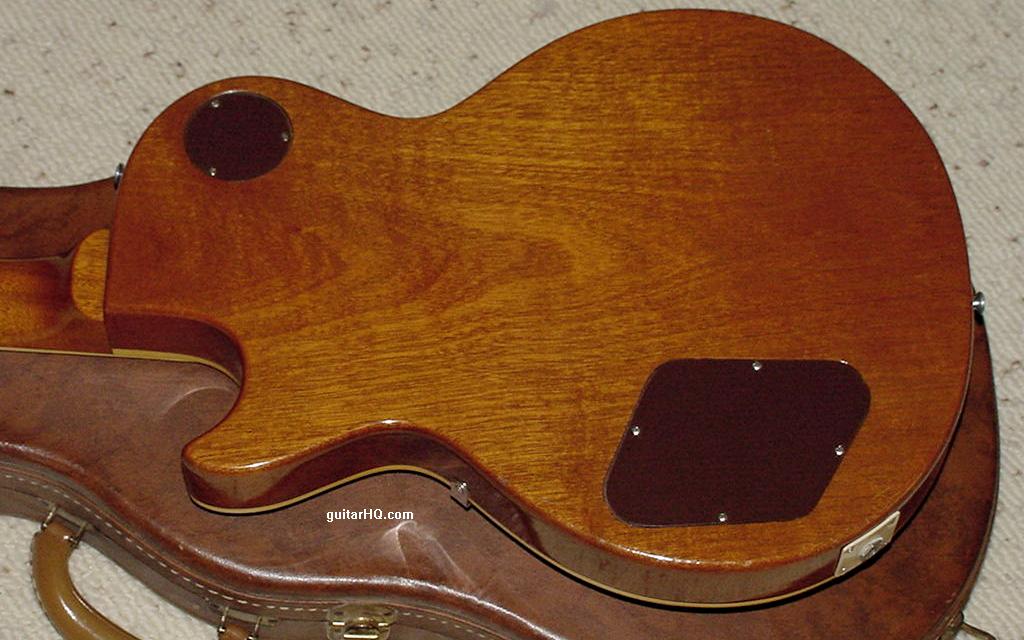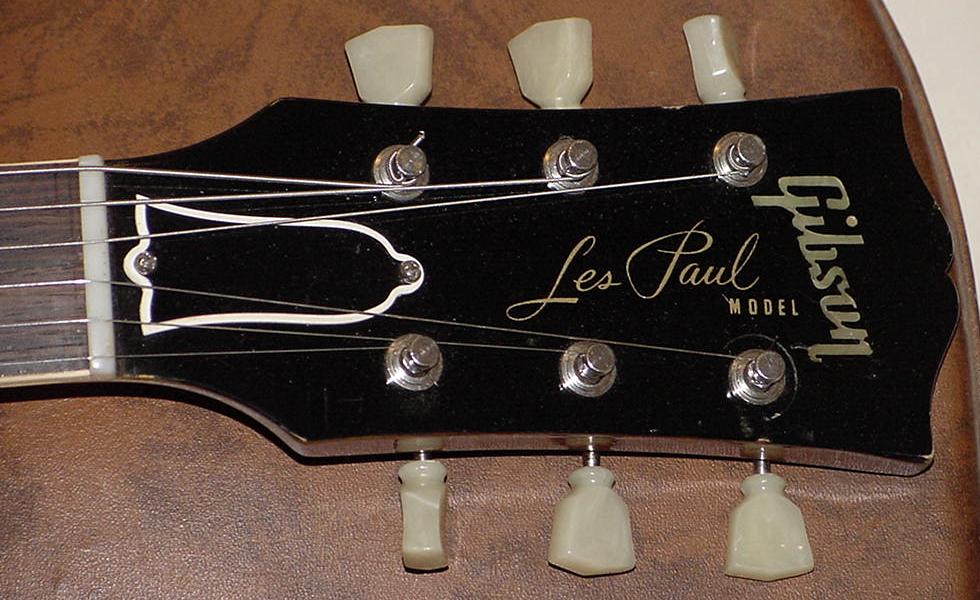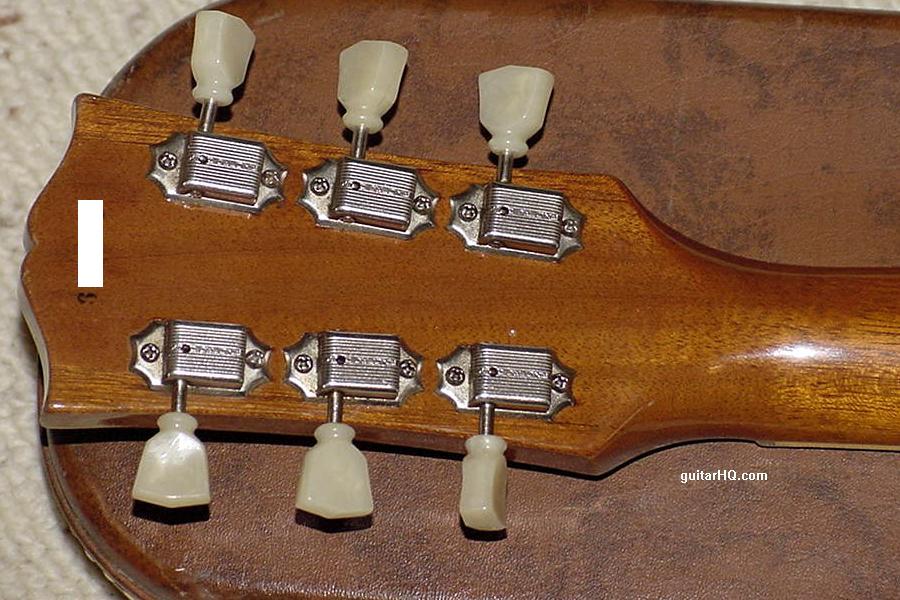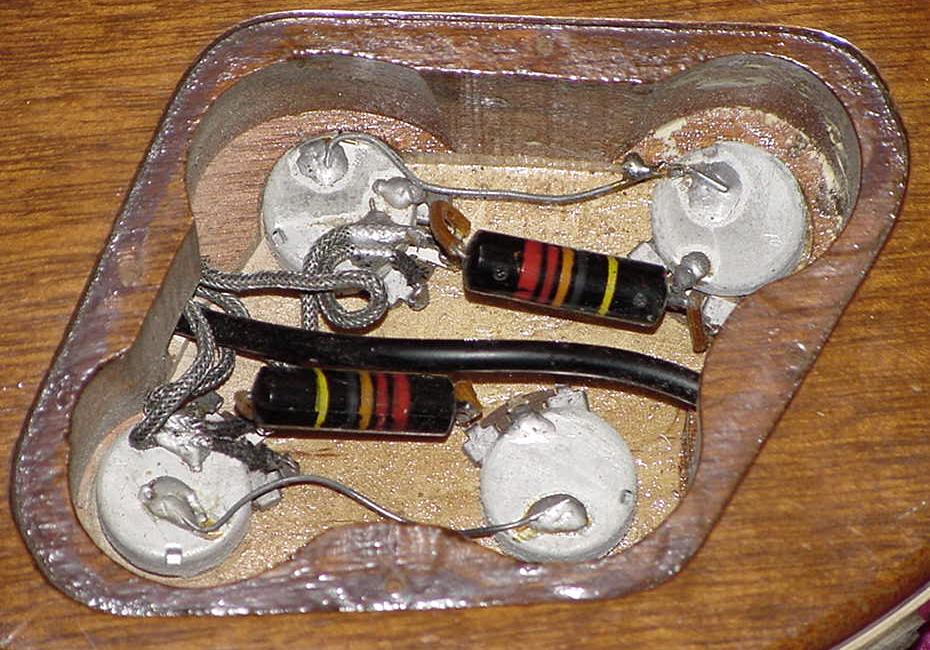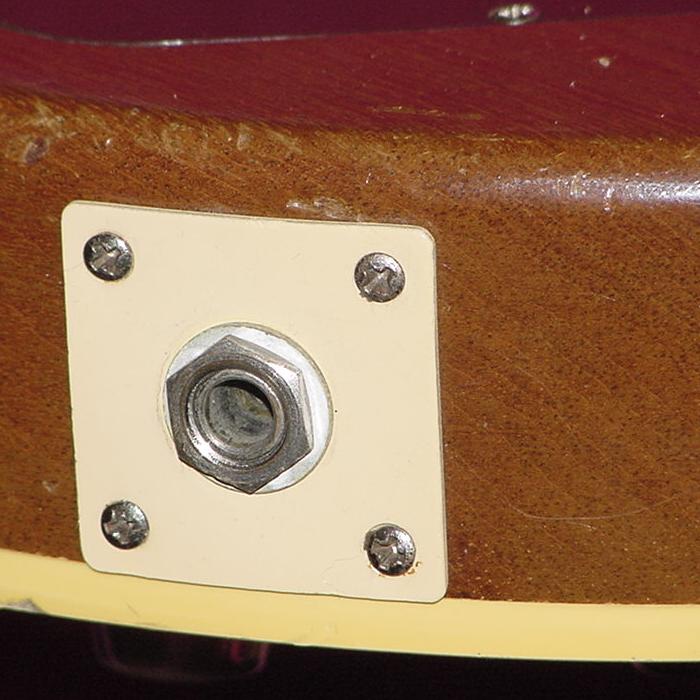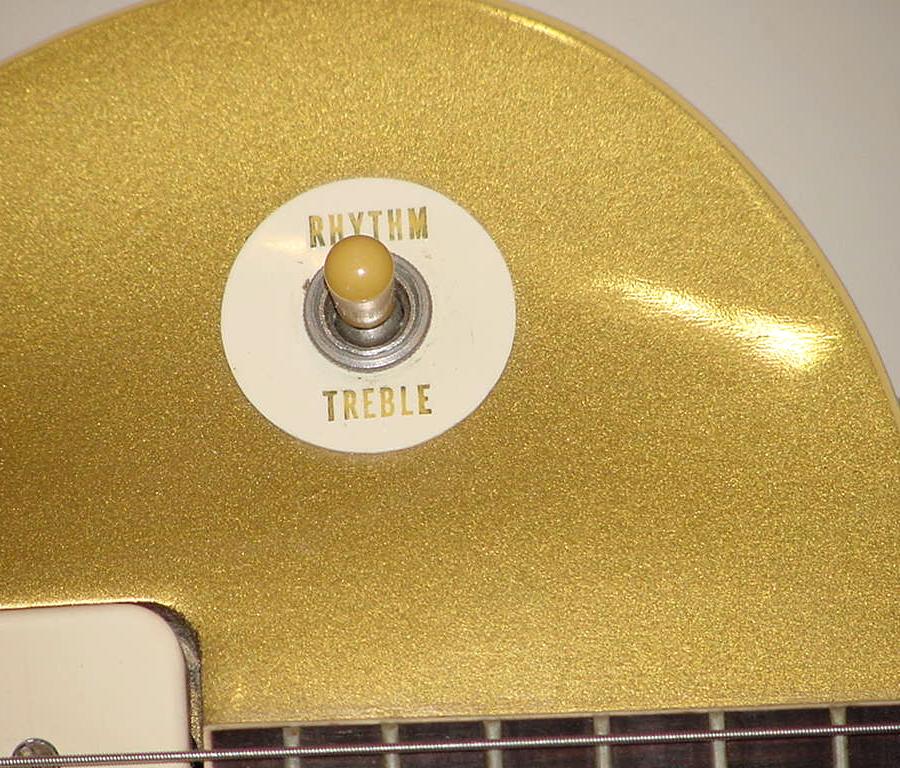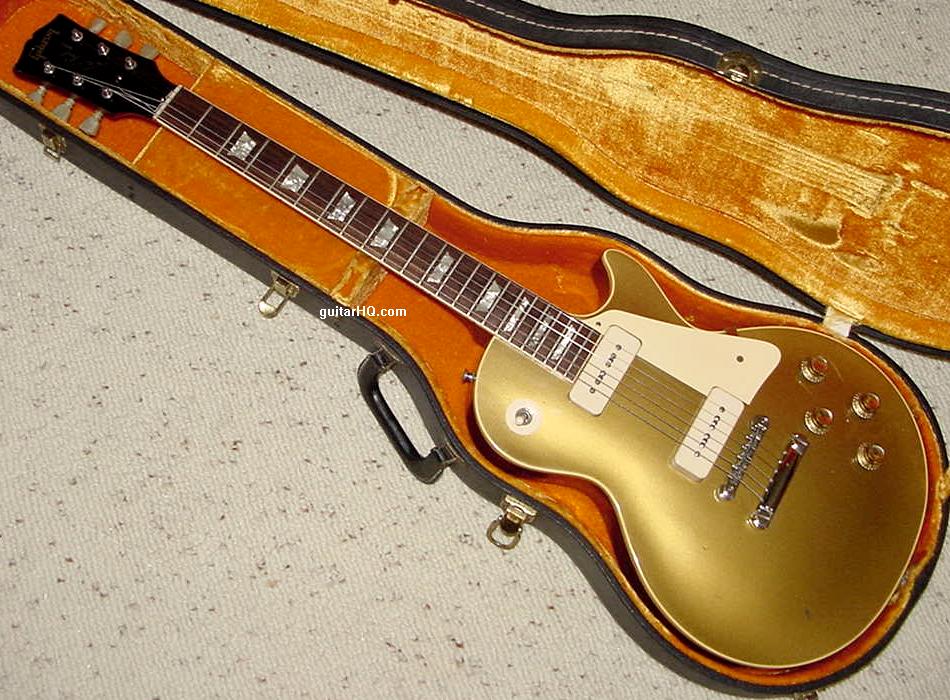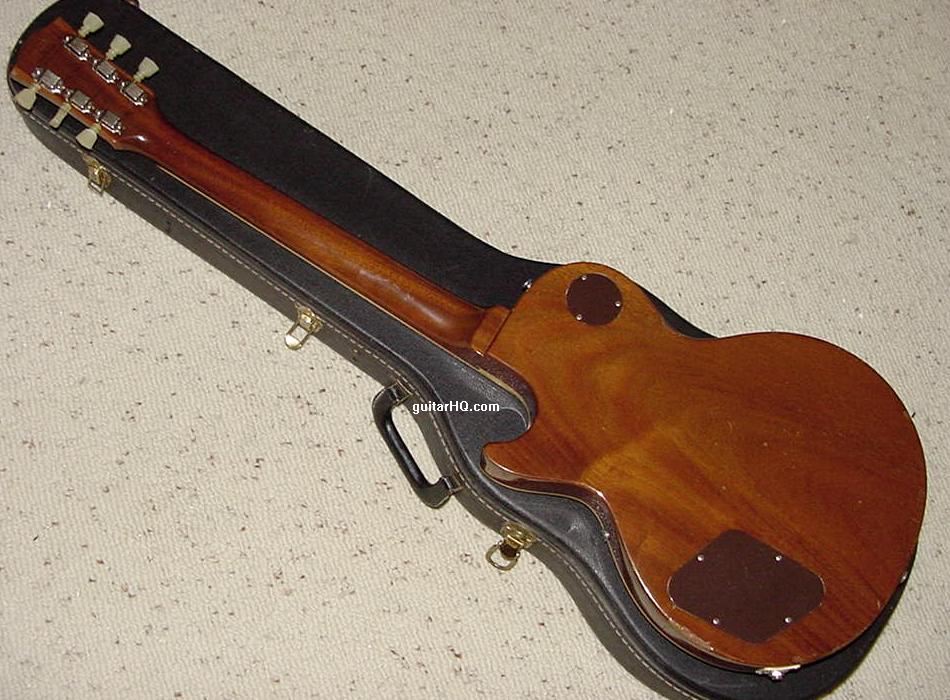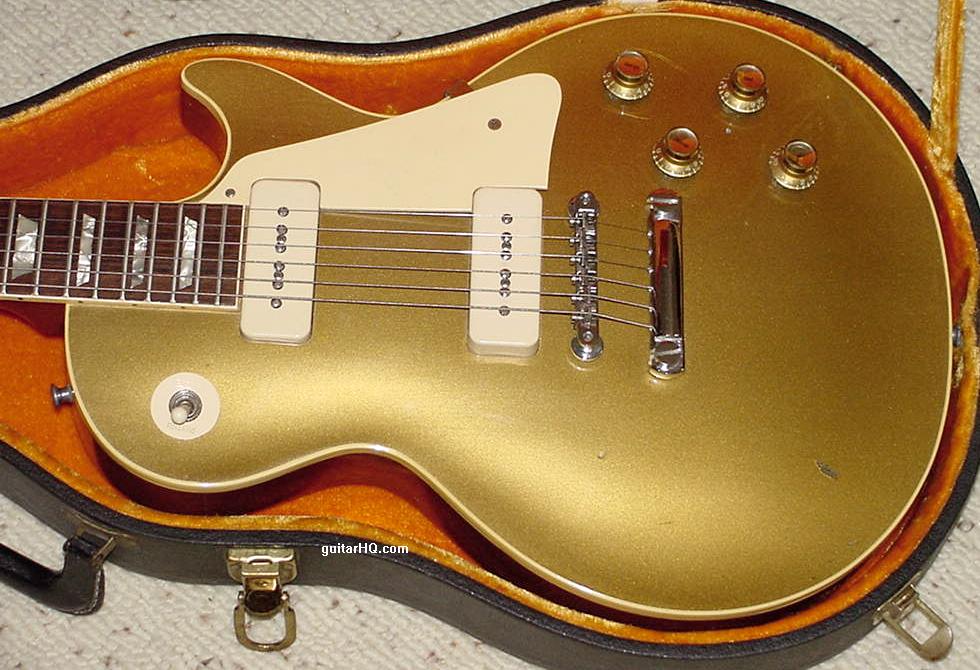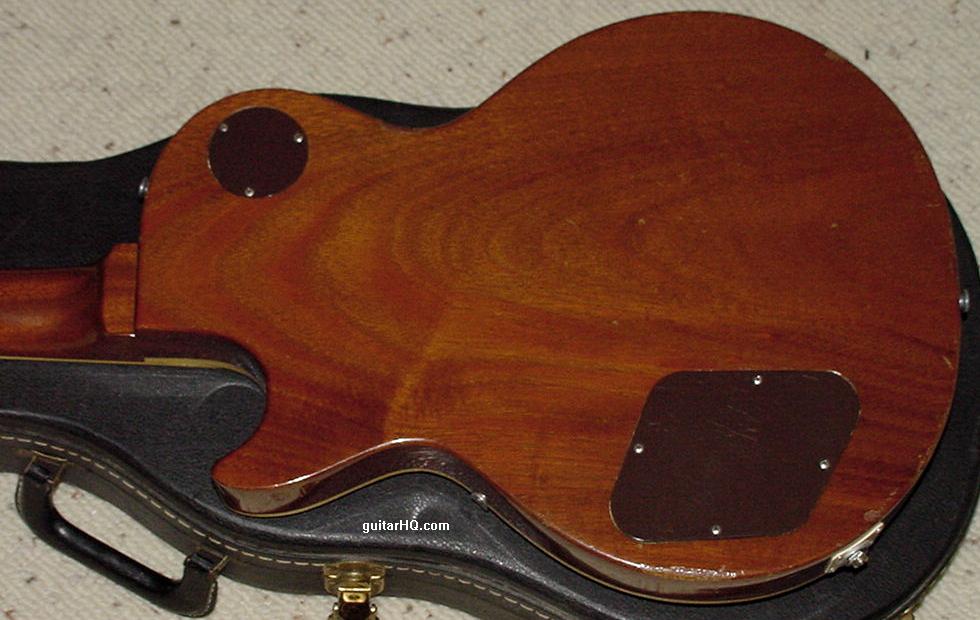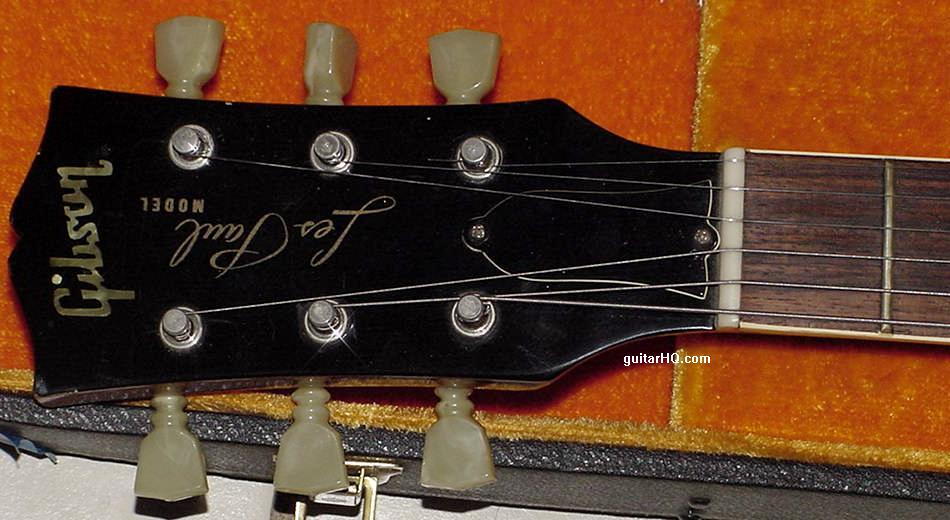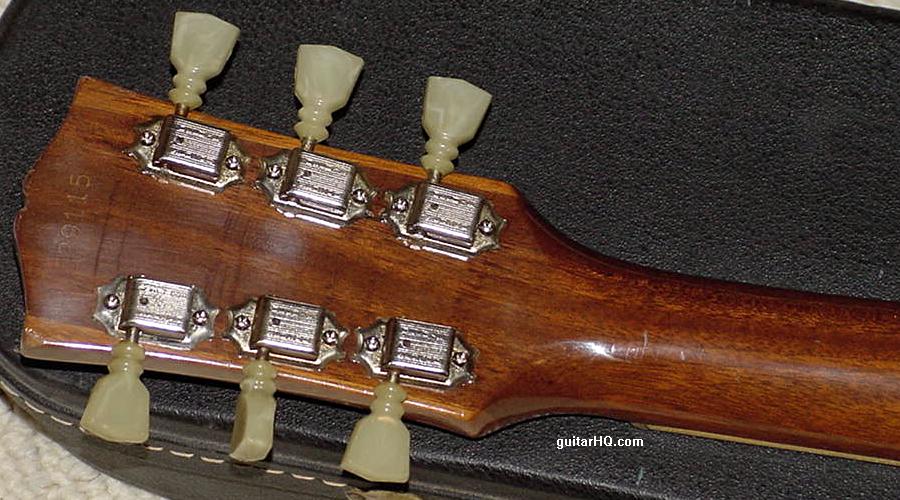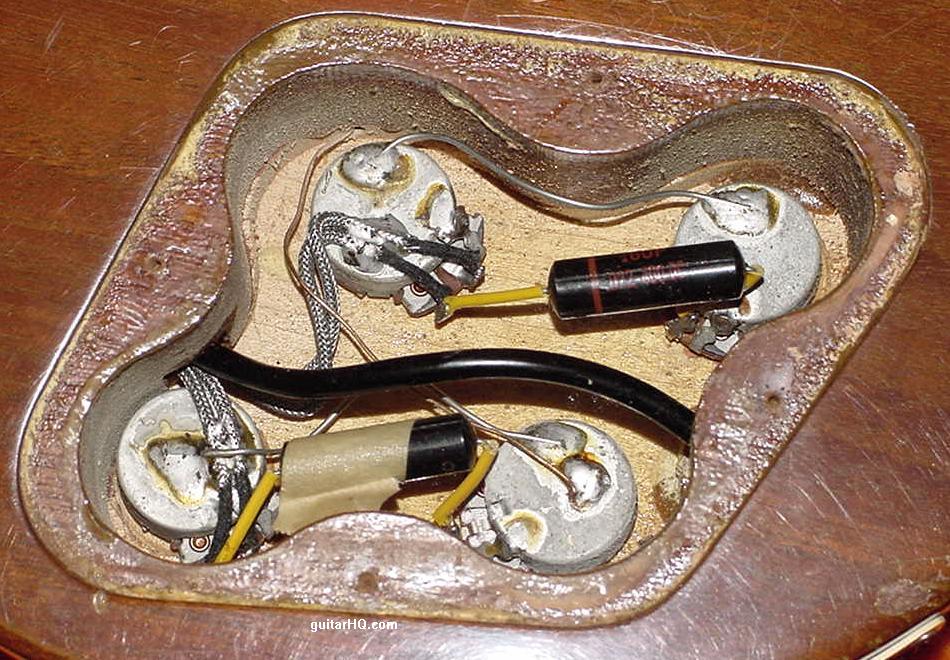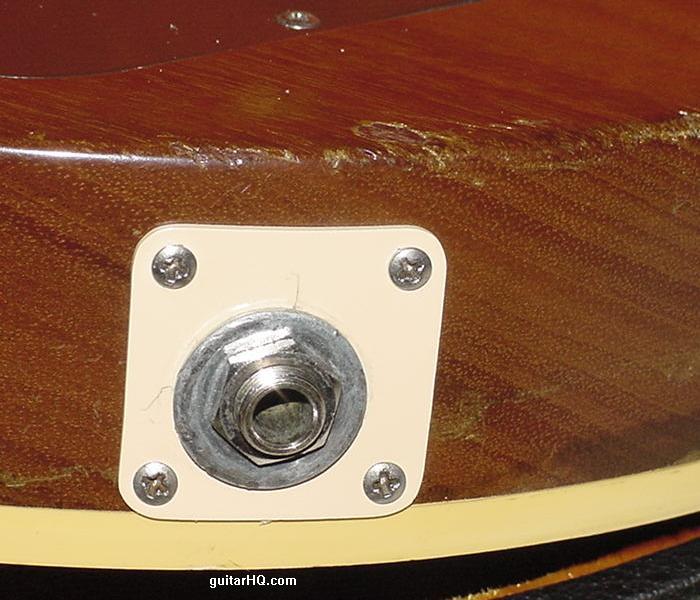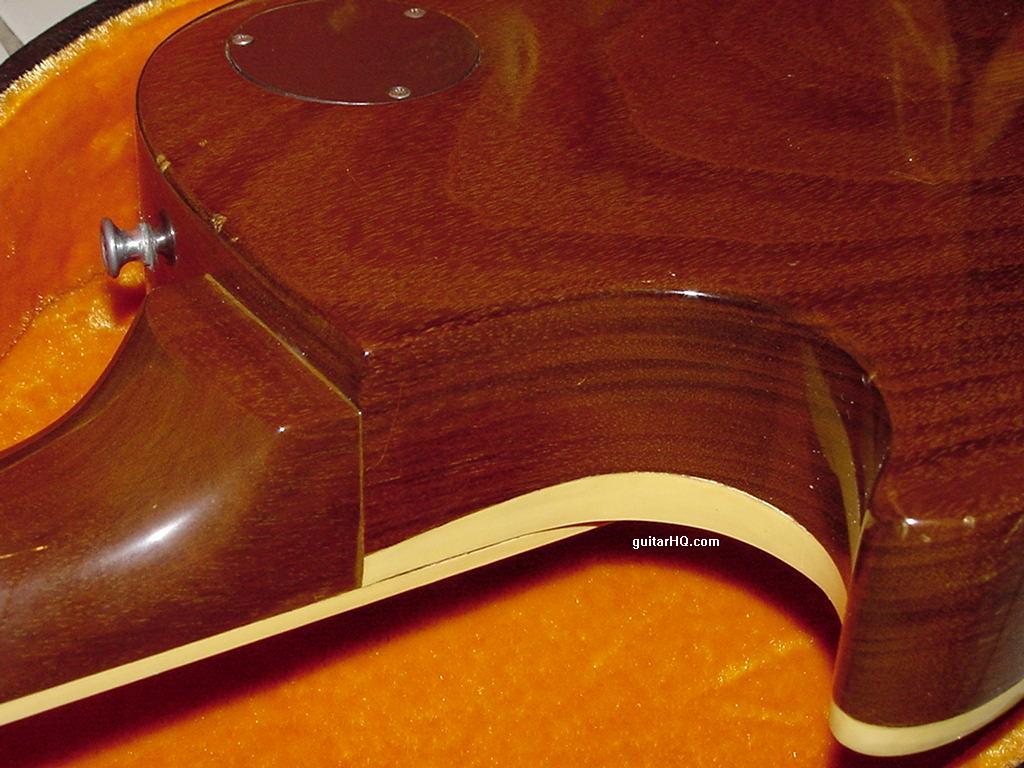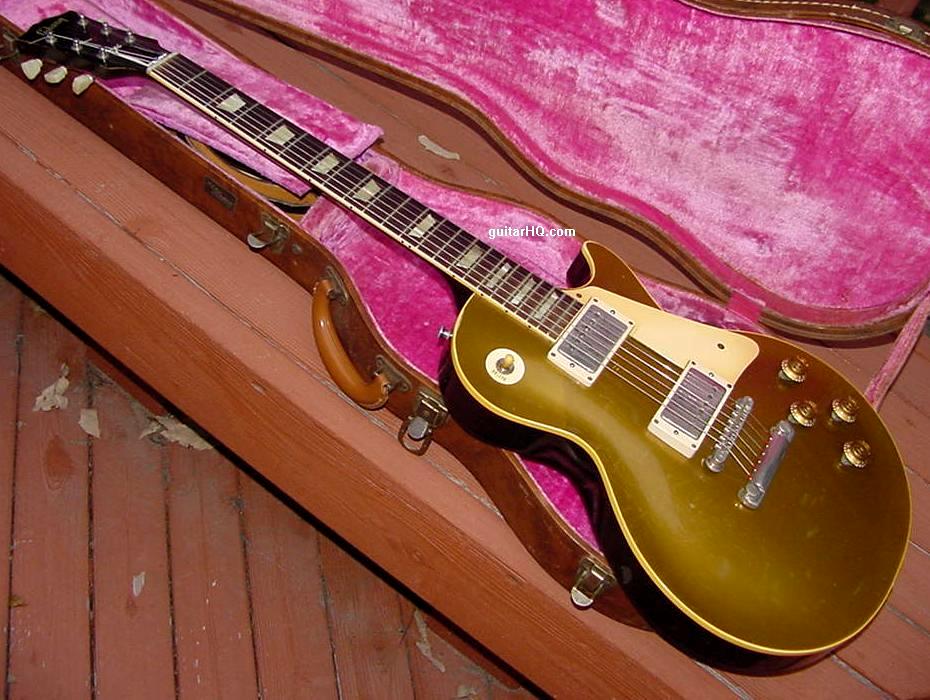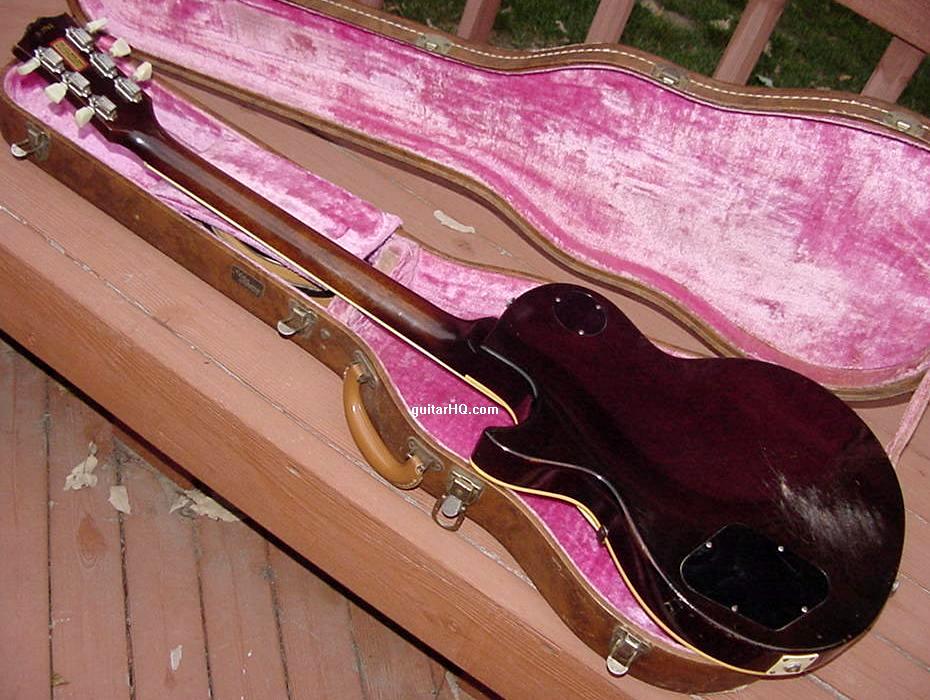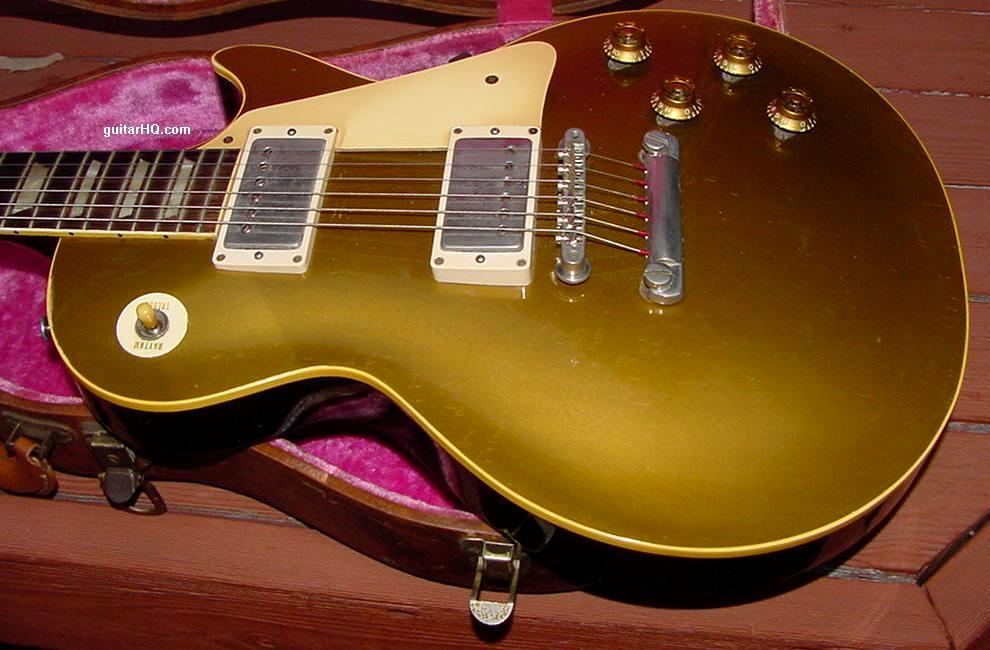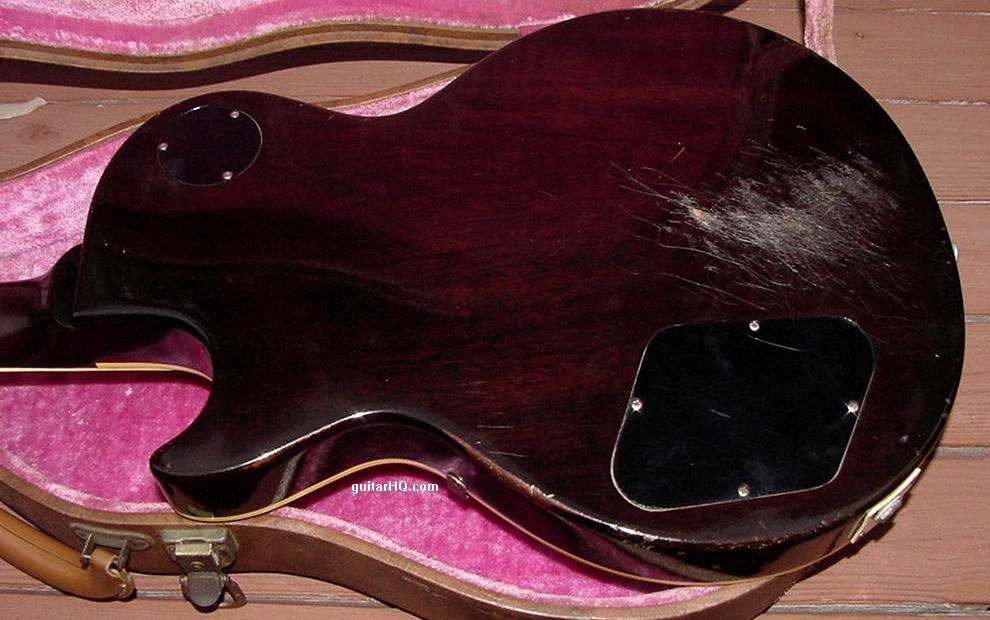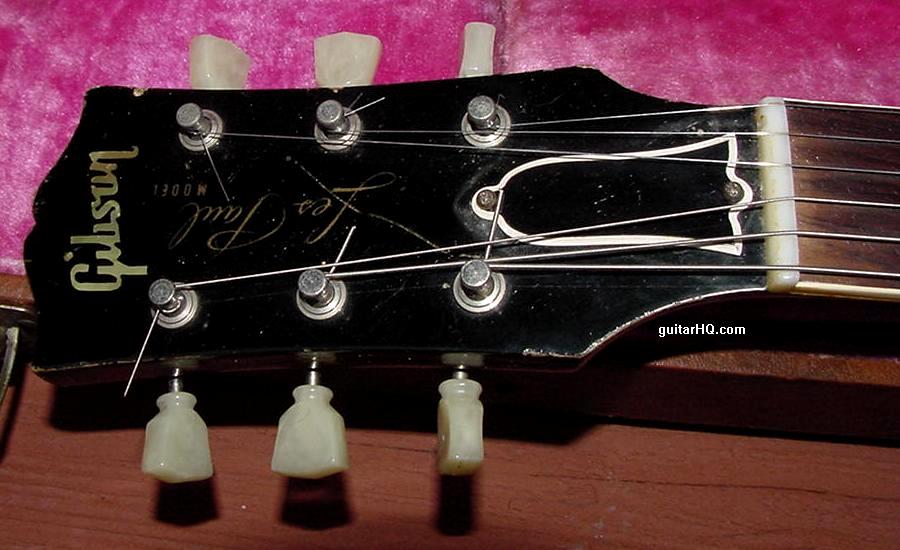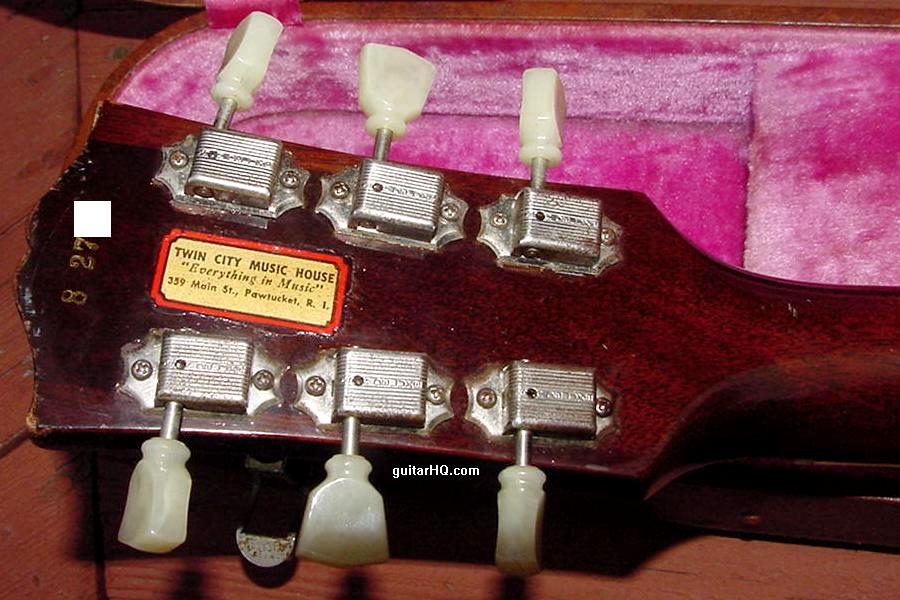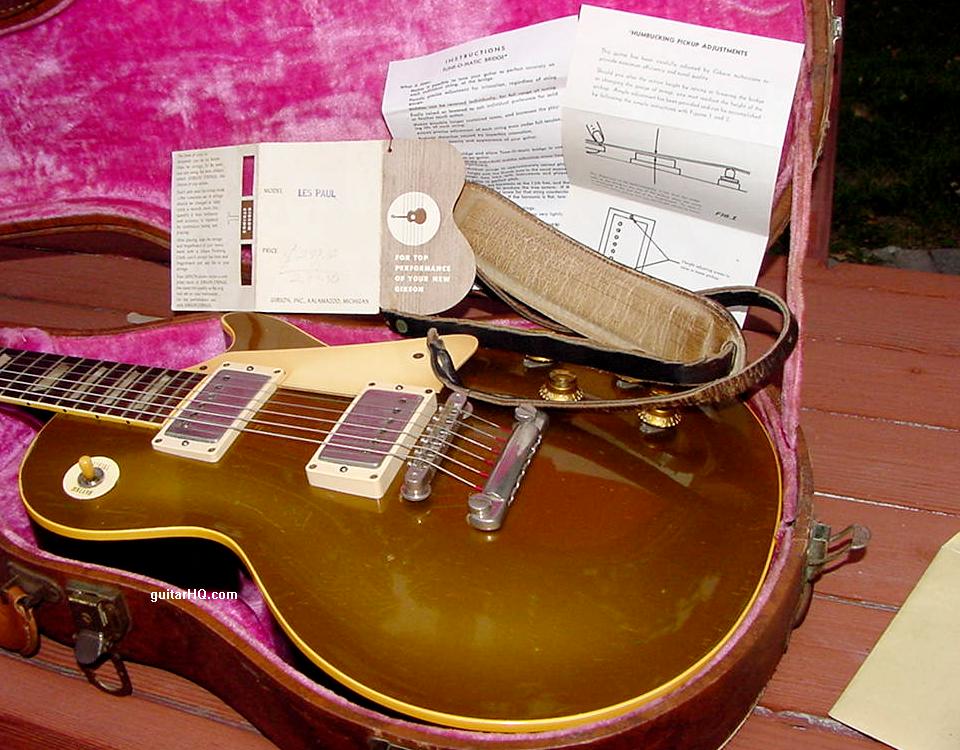|
1955 to 1958 Gibson Les Paul Goldtop Guitar
Description: 1955 to 1958 Gibson Les Paul Standard Goldtop solidbody guitar
Available: 1952 to present.
Collectibility Rating: 1955-1957: A-, 1957-1958: A, 1968: B.
If you have a vintage Gibson Les Paul Goldtop guitar for sale (any year from the 1950s),
please contact me at
cfh@provide.net
General Comments:
By fall 1955, the tuneamatic bridge and stop tailpiece was adopted on
the Les Paul Goldtop (solving the earlier intonation complaints),
making the 1955 to 1958 Gibson Les Paul Goldtop a big winner. The combination
of P-90 pickups and a tunematic/stop tailpiece is considered by most Les Paul
players as a great setup. Hence the late 1955 to early 1957 Les Paul Standard
Goldtop is regarded as a very usable and versatile guitar. They played great,
sounded great, and looked great. How could it be improved?
The tune-a-matic bridge was fitted to a great number of Gibson guitars
during 1954-1955 including the Les Paul. It was a great addition to the
solidbody line of guitars.
In early-1957, Gibson changed from P-90 single coil pickups to their new
humbucking pickups, making the Les Paul Standard what it is today (one of
the most popular electric guitars of all time). The humbucker goldtop is
an amazing model and one I would love to find (please email me if you have one for sale!)
The new humbucking pickups were not met enthusiastically by players at first.
Most Les Paul players still wanted and used the P-90 goldtop models. But this
idea eventually changed, making the humbucking pickup Les Paul models very
desirable.
The humbucking pickups were designed by the
engineer Seth Lover, who sought a way of eliminating the 60 cycle hum and
other interference that single coil pickups exhibited (single coil pickups
include the P-90 pickup).
His idea was very simple - make a pickup with two smaller pickup
coils instead of one big coil, and wire the two coils in series and out-of-phase.
This way the hum from one coil cancels the hum from the other.
The resulting pickup was
not merely one that had no hum, but also that the sound was different. Humbuckers
generally produce a higher output signal and also a mellower tone with greater
midrange and less treble frequencies.
The newly designed humbuckers fitted in the 1957 Les Paul goldtops came to be
known as "PAF" pickups. This was due to the "Patent Applied For" decal on
the bottom side of the pickups. The patent for these was applied for in
1955 and granted in 1959, but Gibson still continued to label their humbucking pickups as
"PAF" for at least another three years (in 1963 the PAF label was replaced
with "Patent Number" label).
Gibson seemed to be in no hurry to apply the patent number to their
pickups even after the patent was granted. This was probably
to not help the competition copy
their pickup design, by telling them which patent to look up at
the US Patent Office.
The final change to the Gibson Les Paul was in 1958, which was largely a visual change.
The finish was changed from a "goldtop" to a sunburst. Also the back of the guitar
was changed from a brown to a cherry red color. Mid-1958 to 1960 "sunburst" Les Paul Standards
are consider to be one of the most attractive electric guitars ever produced
(even though they are identical to the 1957/1958 humbucking goldtop model, except for the finish).
See the 1952 to 1955 Gibson Les Paul Goldtop.
See the 1958 to 1960 Gibson Les Paul Sunburst.
If you need to figure out the exact year of your Gibson Les Paul Goldtop, use the Serial Number.
See the Gibson Serial Number Info web page
for help determining the exact year.
If you have a vintage Gibson Les Paul Goldtop guitar for sale (any year from the 1950s),
please contact me at
cfh@provide.net
- Fall 1955 to Early 1957 Gibson Les Paul goldtop model guitar specs:
-
Tune-o-matic bridge added
(with "ABR-1" on the bottom side of the bridge and no wire to hold the saddles
in place), stud tailpiece
moved back to anchor strings (stop tailpiece). This happened around serial number
"510xxx". The "Gibson" peghead logo moved
down slightly from the top edge of the peghead (some 1954 models are seen with this lower
Gibson logo.)
Tuners now had "Kluson Deluxe" stamped in the gear cover in a vertical line.
The four knobs change from a barrel shape to a top-hat ("bonnet") shape in 1955.
The tone capacitors for (all) Les Paul models changed in late 1955. Prior to this
they used a brown waxy looking tubular Sprague capacitor called the Sprague
"grey tiger". But by 1956 this
changed to Sprague's "bumble bee" tube cap, which was black with colored
value stripes (in the 1968 the same capacitor was again used on the single
cutaway Les Paul standard reissues, but Sprague has changed the marketing
name of the capacitor to "Black Beauty"). The
Bumblebee caps were used from 1956 until 1960 for all pre-SG
Les Paul models (Juniors, Specials, Standards, Customs).
- 1957 Gibson Les Paul goldtop model guitar specs:
-
Some 1957 and 1958 Les Paul goldtops are seen with dark brown backs (also some 1956 models).
These "dark backs" are easy to identify by the serial number, which is
ink stamped with yellow ink (instead of black ink, as used on the light color
backed goldtops). Also darkback Les Pauls will have black control cavity
plates (as used on the Les Paul Custom) instead of brown plates.
Rare, but sometimes seen, are 1957 gold tops with a mahogany top
(a single one piece body with no maple cap - the mahogany can easily
be seen from inside the control cavity route).
Humbucking PAF pickups
replace P-90 pickups around serial number "7 2000" to "7 3800" range
(latest 1957 goldtop documented with P-90s is serial number "7 38xx", and
the earliest is a leftie PAF goldtop "7 13xx").
During this period there was definately overlaps of Goldtops with either
P90 or PAF pickups. First few months of humbucker pickup
production used brushed stainless steel pickup covers
(instead of nickel plated covers) with no PAF stickers.
Resistance of the new pickups ranged from 7.0k ohms to 8.9k ohms.
The first month of humbucker Les Paul goldtop production used
black plastic parts (pickguard, pickup rings, switch surround), with black
parts being in the serial number range "7 13xx" to "7 32xx". All black plastic 1957 Les Paul
Goldtops should have a dark back (if it doesn't, chances are
someone stole the cream parts and replaced them with black parts).
The black pickguard is basically a 5 layer b/w/b/w/b Les Paul Custom
pickguard (but cut for two humbucking pickups).
Within a month or two, PAF goldtops changed to cream plastic parts
(cream part PAF goldtops not seen before serial number "7 3000").
Generally speaking black plastic part 1957 Les Paul goldtops
are worth less than cream part 1957 goldtops though.
The black and cream plastic humbucker pickup
mounting rings had "M-69" as part of the molding, on the bottom
side between the height adjustment screw and mounting screw.
Also the plastic humbucker rings had four "screw tunnels"
for each mounting screw (but not for the two pickup height adjustment
screws). Though the M-69 pickup surrounds were used until about 1970 (in black,
when they were replaced by the M-8 pickup rings with no screw tunnels),
Gibson did not use cream colored M-69 pickup rings any later than 1960.
That's why there's such a big deal about original
cream-colored 1950s Les Paul pickup rings, because original M-69s in cream
were unavailable after 1960. Though these seems like minor details,
original plastic parts are important to these guitars.
The mounting screws for white pickup rings are nickel plated,
for black pickup rings the mounting screws are black.
In 1957 the Rhytm/Treble ring plastic got slightly thicker changing from
.20" thick to about .25" thick. The R/T ring stayed like this until
early-1959 when the font on the R/T ring changed getting thinner.
Also the "Gibson" peghead pearly logo moved closer to the
top edge of the peghead (as positioned on all other Gibson models)
in late 1957 (1957 PAF Goldtops can have either the low or higher
position "Gibson" peghead logo). The logo changed from 3/4" from the
top of the "b" to the tip of the peghead to about 3/8".
- Mid-1958 Gibson Les Paul Standard guitar specs:
-
Model name changed from "Les Paul Model" to "Les Paul Standard".
Sunburst finish replaces Goldtop finish in the fall of 1958, around serial
numbers in the "8 5300" range (though the first known Sunburst Les Paul
has serial number "8 3322"). The maple top on a 1958 to 1960 Sunburst Les Paul
is always two pieces and "center seamed" (there is NO exception to this rule,
except for one of the first 1958 sunburst Les Pauls with serial number "8 3322";
if a Sunburst Les Paul does not have a two piece center seamed maple top, it is
a refinished Goldtop!)
- 1968 Gibson Les Paul Standard goldtop guitar Re-introduction specs:
-
1st reissue of
the 1956 style Les Paul Standard started in August 1968,
with a single cutaway mahogany body (one piece) with
a center seamed maple top, goldtop finish, tuneamatic bridge,
small (narrow width 1950's style) peghead, P-90 pickups. Neck is a single piece
of mahogany with two small "wings" glued to the side of the peghead (50s style
contruction). Tuners are nickle plated double-lined, double-ring style Klusons with
plastic buttons that say "Gibson Deluxe" vertically. The binding in the
cutaway gets wider than it's 1950's counterpart, completely covering
the maple top (unlike the 1950s binding which shows a slice of the maple
top in the cutaway below the binding). Also the serial number
is stamped into the wood at the back of the peghead, all metal
parts (except tuners) are chrome (not nickel), and the gold knobs have metal inserts
in the tops with "volume" and "tone" printed on them. The neck also has a
14 degree peghead pitch instead of 17 degrees, and Indian rosewood fingerboard instead
of Brazilian. The fingerboard inlays have a different look too, because it's
a different block of celluloid than the 1950s guitars.
The very few first LP Standards of 1968 had a crown peghead inlay (like an
ES-335) instead of the gold "Les Paul" signature. This existed on examples
in the 501xx to 505xxx serial number range. The truss rod cover was pantographed
with "Les Paul". With serial number series 513xxx,
the peghead changed to the silkscreen "les paul" signature
on the peghead (like 1950s Les Pauls), and the truss rod cover was now blank.
Another strange feature of these first 1968 Goldtops is
the strap button on the non-cutaway side is mounted too
far away from the neck to be of any use.
On the back of the body the round edging is more "round" than normal
on the first 1968 Les Paul gold tops.
Also the neck tenon (the part of the neck's tongue seen in the neck pickup route,
how the neck connects to the body)
is considered "long", and like 1950s contruction. If you remove the neck p90
pickup, you'll see the tenon goes well into the pickup cavity
(the tenon is about 3/4" long inside the neck pickup cavity).
Other than that,
1968 goldtops look and are constructed just like 1956 LP goldtops
(except the weight of these guitars tends to be much heavier than the 1956 models).
Most 1968 Les Pauls use Sprague "black beauty"
tone capacitors, but also some use the SG-era brown disc capacitors.
The control cavity route in 1968 is different too, as it was routed
all the way thru the mahogany body *before* the maple top was glued on.
There is no "bite" mark in the cavity as seen in the 1950s Les Pauls.
That is, the walls of the control cavity are straight, and the floor is flat
(1950s models have a contoured cavity floor). The wiring route is a square
route (not a drilled hole). Note the rumor that 1968 Les Pauls used leftover
1950s bodies is completely untrue.
- Early Gibson 1969 Les Paul Standard Goldtop guitar specs:
- In December 1968 the Les Paul went through some transitions.
1969 serial numbers start in the 530xxx range.
Around serial number 542xxx, the peghead get wider and uglier
to match the Les Paul Custom's headstock.
Only a handful of January 1969 Les Paul Stanards had the earlier 1968 style narrow peghead.
The "dot" in the "i" of the Gibson logo is missing in 1969 (still using
the open "b" and open "o" logo though) starting around serial number 539xxx.
Starting in February 1969 the control cavity was routed like 1950s
guitars with the maple top glued in place. This can be seen because
the maple has a slightly routed step, where on January 1969 and 1968 Les Pauls
the maple has absolutely no routing marks.
- Mid 1969 Gibson Les Paul Standard goldtop guitar specs:
-
Lots of changes to the model starting around April 1969, and transitioning through the summer.
First the center seamed maple top is gone,
with multiple pieces of maple being used (hard to see on a goldtop finish, but
you can usually see the seams). The neck tenon is now considered "small",
with it only extending about 1/4" inside the neck pickup cavity. Sometimes
the bodies were routed for long tenon necks, but a short tenon neck was installed.
If this happens, a block of wood is glue there to fill the gap.
Also the "cross banded" (pancake) 3-piece Les Paul body started around April,
with a thin layer of maple sandwiched between the mahogany body back.
This first generation of the pancake body had the thin maple pancake close
to the top of the body.
In June 1969 the pickups change to mini-humbuckers, and the guitar is
renamed the "Les Paul Deluxe" ("Deluxe" is pantographed into the truss rod cover).
Serial numbers for mid-1969 to late Les Pauls all seem to be in the 800xxx to 893xxx range.
By mid-1969 the maple pancake layer moved to the dead
middle of the mahogany portion of the Les Paul body.
Staring December 1969, beneath serial number, it says "made in USA" and has a
small "volute" on the back of the neck
in the nut area (a vulute is a ski-jump like bump on the back of the neck).
|
